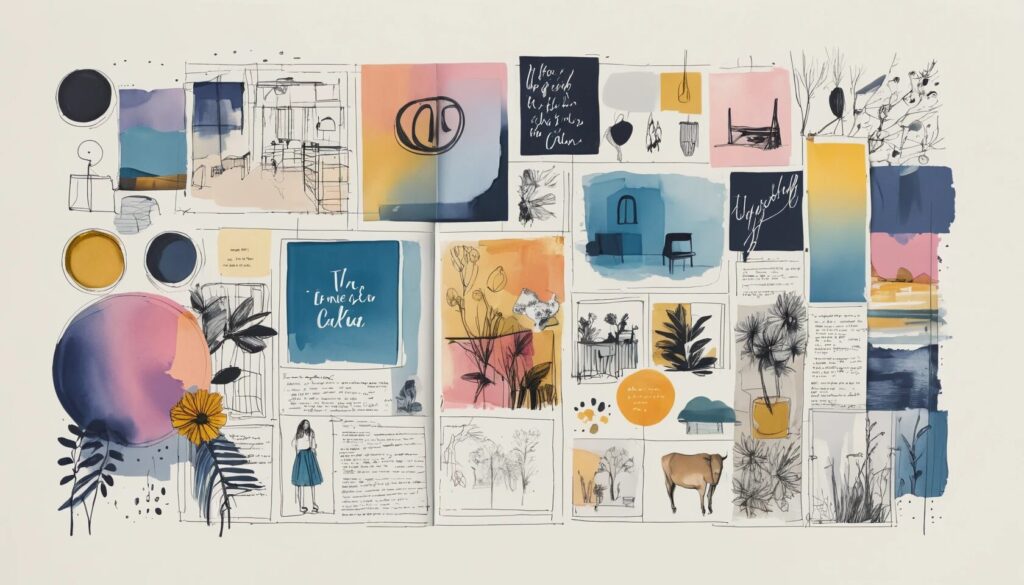Mastering Moodboard Creation: The Secret to Effortless Creativity
Picture this: You have a brilliant idea brewing, but when you sit down to visualize it, your mind is as blank as an empty Word document. Frustrating, right? Enter moodboards—the unsung heroes of the creative world. Whether you’re crafting a brand identity, designing an interior space, or mapping out a film aesthetic, moodboards are your ultimate creative compass.
Forget scissors and glue—this is the digital age! With intuitive digital moodboard tools like Milanote, you can easily curate, refine, and share your vision in real time. But how do you go from a chaotic jumble of ideas to a stunning, collaborative moodboard design that wows clients and colleagues alike? Buckle up, because we’re about to unveil the ten steps that will elevate your moodboard game.
Step 1: Define Your Creative Vision
- Clarify your project’s purpose and goals.
- Establish a strong theme or aesthetic direction.
- Use descriptive keywords to guide your creative process.
Before you dive headfirst into moodboard creation, take a moment to define your goal. Are you setting the tone for a brand? Planning a wedding? Designing a futuristic sci-fi film set? Whatever the case, a strong vision is your foundation. Jot down words that encapsulate your idea—sleek, moody, vintage, minimalist—these will help refine your choices.
Step 2: Collect Your Inspiration Like a Pro
- Gather images, textures, and typography that reflect your theme.
- Explore platforms like Pinterest and Behance for fresh ideas.
- Include sketches, brand assets, or even personal photos.
This is the part where you embrace your inner digital hoarder. Scour the internet for anything that speaks to your theme—photos, fonts, textures, and even music. Platforms like Pinterest and Behance are bottomless wells of inspiration. If you’re working on a branding project, include logos, color palettes, and existing design elements to maintain cohesiveness.
Step 3: Organize and Arrange for Maximum Impact
- Establish a visual hierarchy by prioritizing key elements.
- Group similar items together for a cohesive layout.
- Experiment with different compositions until it feels right.
At first, your moodboard may look like a chaotic mess—but don’t panic. The magic lies in arrangement. Use Milanote to drag and drop elements effortlessly. Larger, dominant visuals should anchor your board, while smaller details provide depth. Think of yourself as a curator, placing each piece with intention.
Step 4: Establish a Cohesive Color Palette
- Extract colors from images to maintain harmony.
- Use tools like Coolors for complementary color schemes.
- Ensure color choices align with the mood of your project.
A moodboard without a color scheme is like coffee without caffeine—pointless. Use a color-picking tool to extract hues from your images and build a palette that enhances your theme. Need some help? Coolors generates stunning combinations at the click of a button.
Step 5: Select Typography That Speaks Volumes
- Choose fonts that align with your project’s personality.
- Pair complementary typefaces for balance.
- Use Typewolf for expert font pairing inspiration.
Typography is more than just letters—it’s an attitude. Whether you’re aiming for elegance, boldness, or whimsy, the right font can make all the difference. Play with combinations, but keep it simple. Too many fonts, and your board starts looking like a ransom note.
Step 6: Incorporate Motion and Sound for Extra Flair
- Add GIFs or videos to capture movement.
- Use sound clips to enhance mood and emotion.
- Ensure interactive elements complement the overall aesthetic.
Why settle for a static board when you can add life to it? Digital moodboards allow you to embed videos, GIFs, and even sound clips. If you’re designing for a film or fashion project, incorporating movement gives a richer, more immersive experience.
Step 7: Collaborate and Refine with Your Team
- Invite team members to contribute in real-time.
- Use comments to provide constructive feedback.
- Ensure alignment by refining together.
Creativity is rarely a solo act. With collaborative moodboard design features in Milanote, your team can add ideas, tweak layouts, and provide feedback in real time. This ensures everyone is on the same page—without the endless email chains.
Step 8: Edit Ruthlessly—Less is More
- Remove elements that don’t serve the vision.
- Adjust spacing for a polished, intentional look.
- Step away and revisit with fresh eyes.
More isn’t always better. If an element doesn’t contribute to the moodboard’s overall story, cut it. Editing is where good moodboards become great. And if you’re unsure? Take a break and return later with renewed perspective.
Step 9: Label Key Elements for Clarity
- Add captions to explain design choices.
- Use annotations to highlight essential details.
- Ensure anyone viewing the board understands its purpose.
Not everyone can read your mind (unfortunately). Add captions or labels to clarify why certain elements were chosen. This is especially helpful when presenting to clients or team members unfamiliar with your thought process.
Step 10: Finalize and Use Your Moodboard as a Guide
- Ensure all components align with your creative vision.
- Use the board as a reference throughout your project.
- Create variations for alternative directions if needed.
Once your moodboard is polished, it becomes your creative roadmap. Refer to it throughout your project to maintain consistency. Need an alternate version? No problem—create multiple boards to explore different aesthetic directions.
Turn Chaos into Creativity with a Moodboard
Creativity may feel chaotic, but a well-structured moodboard brings order to the madness. By following these ten steps, you’ll transform scattered ideas into a cohesive, compelling vision that captivates both clients and collaborators. Whether you’re a designer, filmmaker, or creative strategist, a thoughtfully crafted moodboard is your secret weapon.
Ready to bring your ideas to life? Explore Milanote’s moodboard templates and start creating your masterpiece today.
